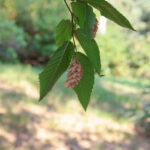Black Tupelo, Nyssa, is a deciduous tree that grows to 50 feet tall or more. Its simple leaves turn flaming red in the fall and the bold crooked twiggy branches make a picturesque outline against the sky in winter.
Nyssa is a genus of North American deciduous leaves. Small greenish-white flowers are followed by purple or blue fruits.
Nyssa grow naturally in moist situation in the southern half of the United States.
They are easily propagated from seed either stratified or sown as soon as ripe.
Get to know Black Tupelo
- Plant type: Deciduous tree
- Growing Zones and range: 4-8
- Hardiness: Hardy
- Height and spread: 90 feet (27m) tall and 45 feet (13.5m) wide; pyramidal form
- Foliage: Leaves are leathery and glossy dark green turning orange or scarlet in fall
- Flowers: Greenish white flowers; followed by small blue fruits on female trees in midsummer
- Bloom time: Late spring
- Uses: Specimen tree, woodland garden, fall color
- Botanical name: Nyssa sylvatica
- Common name: Black Tupelo, black gum, pepperidge
- Origin: North America
Where to plant Black Tupelo
- Grow Black Tupelo in full sun.
- Plant Black Tupelo in moist, humus-rich, well-drained soil.
- Black Tupelo is intolerant of alkaline soil.
When to plant Black Tupelo
- Transplant balled-and-burlapped or container grown Black Tupelo in early spring.
Planting and spacing Black Tupelo
- Space Black Tupelo 20 to 30 feet apart; trees grow 30 to 50 feet tall.
How to water and feed Black Tupelo
- Keep the soil evenly moist; Black Tupelo tolerates wet and dry conditions.
- Fertilize Black Tupelo by spreading aged compost to the dripline at least once a year.
Black Tupelo care
- Mulch with aged compost to keep the soil moist.
Black Tupelo common problems
- Black Tupelo has few serious pests or diseases.
Black Tupelo propagation
- Sow seed in early spring.
Black Tupelo varieties to grow
- ‘Miss Scarlet’ has outstanding red fall color and large blue berries.



